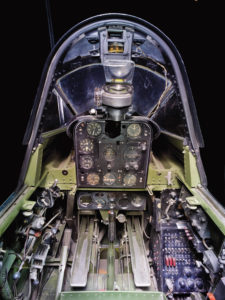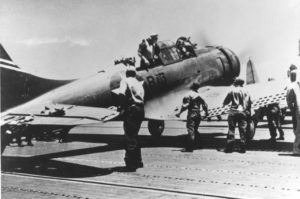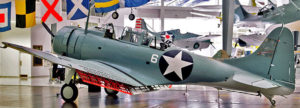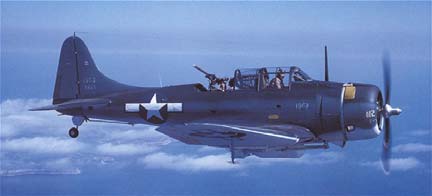They were the Navy’s last chance.
It was 10:20 am on Thursday, June 4, 1942. Forty-seven U. S. Navy dive bombers had found what they were looking for. Far below, four Japanese aircraft carriers were launching the first planes of a massive strike that could decide the Battle of Midway. Two days of American air and submarine attacks had failed to damage a single ship of the peerless Japanese Aircraft Carrier Striking Force. The priceless intelligence advantage the Americans had gained through years of backbreaking effort by Navy codebreakers was about to be squandered. The heroic sacrifice of Navy torpedo plane crews who had pressed home their slow-motion attacks in the face of deadly Japanese opposition looked to be in vain.
But now, at the last possible moment, three squadrons of SBD Dauntless dive bombers from the American aircraft carriers USS Yorktown and USS Enterprise had arrived unobserved and unopposed in the skies above the Japanese fleet.
Somehow, against all odds, the Americans had achieved precisely the situation that Navy commanders had dreamed of: dozens of American dive bombers screaming down on Japanese flight decks jammed with fueled and armed aircraft, fueling hoses snaked about, bombs and torpedoes scattered hastily throughout the hangar bays.
The broad flight decks of the Japanese carriers were perfect targets for the American pilots whose aircraft, training, and combat tactics had been designed for precisely this type of attack. Dive bombing had been developed by the U.S. Navy in the 1930’s, and in 1942 it was the most accurate form of air attack. That was one reason that Navy carrier air groups had more dive bombers than any other type of aircraft. By pointing his plane directly at the target until he released his weapon, a skilled pilot could keep his eye on the target throughout his dive and simplify his bomb’s trajectory.
No Easy Task
But success was far from certain. This was just the second great carrier versus carrier battle of the Pacific War, and no one yet knew what to expect. Pilots from Yorktown had fought at Coral Sea, but pilots from Enterprise had not. Dive bombers from the third US carrier at Midway, USS Hornet, hadn’t even found the Japanese fleet.
Pre-war doctrine supposed that aircraft carriers couldn’t survive a massed air strike. But at Coral Sea, one month earlier, three of the four fleet aircraft carriers that were attacked – two Japanese and two American – did survive. Yorktown was one of those survivors. Pre-war doctrine also held that B-17s could effectively bomb ships from high altitude, but attacks against Japanese ships by B-17s at Midway scored no hits. It was becoming clear that the real war was going to be different from the war that was envisioned.
The dive bombing attacks themselves would be difficult. Carriers were big targets, but they were moving fast and the American pilots would have to fly precise flight profiles to hit them. During their 40-second dives, the aviators would have to continuously work their rudder pedals and sticks to correct their plane’s speed, heading, and dive angle to remain on target while the carriers maneuvered violently. For much of the dive, the pilots could track their targets through spotting scopes, similar to the scopes that snipers mounted on their rifles. But the scopes simply provided a 3X magnified view; it was up to the pilots to make the necessary adjustments in three axes to ensure a hit.
Today A Computer Would Do It
The plane’s dive flaps held the bomber’s speed to about 276 knots, giving the pilot a little more time to make adjustments, but also making the plane an easier target for enemy anti-aircraft gunners and defending fighters. For gunners on the targeted ships, a diving plane appeared motionless, slowly growing in size as it neared, which greatly simplified their aim. Fortunately for the dive bomber crews, most antiaircraft mounts lacked the ability to fire directly up, so the amount of fire the planes received from the targeted ship was limited.
American dive bombers typically approached their targets at an altitude of around 20,000 feet, flying at more than 200 knots. When they spotted their targets, dive bomber pilots increased speed and descended to about 8,000 feet. Since Japanese ships mostly lacked radar, whenever possible the Americans approached their targets from out of the sun. When over the target, pilots pulled the noses of their planes up to put the aircraft into a stall, opened their dive flaps, and raced down toward their target.
The ideal dive angle was 70 degrees, and the dive might take 30-40 seconds. During that time the rear seat radioman/gunner – on his back, facing the sky – would be nearly weightless, and gunners have described how spent shell casings that had fallen to floor of the plane would drift up past their eyes. The pilot hoped to release his bomb when he was between 2000 and 1500 feet above the target. At that altitude the bomb would fall for less than 10 seconds, but even during that short time a ship evading at 30 kts might move 500 feet.
So, the pilot had to fly a narrow flight profile, continuously adjusting his own deflection, speed, and dive angle to correct for the movement of the target, for the effect of gravity, and for the effect of the wind on his plane and on his bomb, once it was released. He had to correctly estimate the wind direction and speed and the target ship’s current course and speed and aim where the target ship would be when the bomb reached the surface. If the dive angle was slightly off, the bomb would land short or fly past the target. If the plane’s heading was slightly off, the bomb might miss to either side.

Cockpit of SBD-6 dive bomber
(Photo credit: https://airandspace.si.edu/webimages/collections/full/2009-12496.jpg)
Since aircraft – even dive bombers – are designed to fly horizontally, putting a plane into a 70-degree dive alters the forces affecting the aircraft and causes the attacking plane to drift across the target, decreasing accuracy. Dive flaps helped correct this problem, but it was just one more thing that pilots had to contend with.
Today a computer would instantly process the flood of incoming information and fly the correct profile, but in 1942 the pilot was the computer.
Insanely Dangerous
Once the bomb was released, the aviator pulled out of his dive, a maneuver that might leave him struggling to breathe as he experienced as much as six times the force of gravity. These stresses were considerable and dive bombers were built to handle them, but pilots could be rendered briefly unconscious by the forces. If everything went well, the bomber would level off at around 500 feet and the pilot would start jinking rapidly to avoid anti-aircraft fire from enemy ships and defending fighters.
This, of course, was the primary drawback to dive bombing. Pointing your plane at an enemy ship and diving as close as possible before releasing your weapon sounded good in theory and was accurate in practice. But finishing your bombing run directly over your target at 500 feet altitude was insanely dangerous. Shipboard gunners probably couldn’t hit you as you flashed by, just above their masts. But your escape would leave you in antiaircraft range for a long time, and at an altitude of 500 feet you would have little room to maneuver if attacked from above by enemy fighters.
The vulnerability of dive bombers after releasing their weapons was a major reason why the Germans abandoned dive bombing attacks against land targets whenever enemy fighters were present. By mid-1942, a German dive bombers’ life expectancy in combat had fallen to less than five days.
There was nothing easy about hitting a moving target at sea in the face of anti-aircraft fire or defending fighters. The plane is moving, the target is moving, and the air around the plane is moving. It takes many hours of practice and considerable skill. At Midway, Marine Corps pilots who had just received new dive bombers attacked Japanese ships using glide bombing techniques because they had not been sufficiently trained in dive bombing. They scored no hits.
By Chance A Coordinated Attack
By the time the Navy dive bombers arrived above the Japanese carriers, U.S. land-based and carrier-based planes had been attacking the Japanese formation nearly continuously for two hours. While no hits had been achieved, and more than 35 American aircraft had been shot down, the uncoordinated attacks had disrupted Japanese operations, scattered their ships, and drawn Japanese fighter planes down to the surface of the sea.
Two SBD squadrons from Enterprise arrived together, while a third squadron from Yorktown arrived simultaneously from another direction. The coordinated attack was pure chance, as the Americans had made no effort to have all of their attacking planes arrive over the Japanese fleet at the same time. The Yorktown bombers had actually taken off an hour later than the Enterprise planes.
Dive bombers, torpedo bombers, and fighters all had different ranges and speeds, and coordinating their arrival over a moving target whose location at the time of arrival could only be guessed at was impossible in 1942. Planes could only be launched one at a time, so it might take an hour to launch a full strike force. By then, the first planes launched would have used thirty minutes or more worth of fuel circling their own ships. Without knowing exactly where the enemy ships would be when the strike would arrive, it was impossible to calculate courses and speeds that would bring all the planes over the enemy at the same time. At Midway, desperate to strike the Japanese carriers before they could attack the U.S. carriers, American commanders sent their planes off in small groups as soon as they were launched. That decision doomed the torpedo bombers – 39 of 43 were shot down – but inadvertently opened the way for the dive bombers to attack unhindered by Japanese fighters.
Communications Failures Almost Saved a Japanese Carrier
Miscommunication between the attacking SBDs almost spared one of the Japanese carriers. LCDR Wade McClusky, Enterprise Air Group Commander, wanted one of his squadrons to attack the carrier Kaga, and the second to attack carrier Akagi. But the pilots didn’t hear his instructions and both squadrons dove on Kaga. At the last moment, one of the section leaders, Lt. Richard Best, realized what was happening and redirected his five-plane section to attack Akagi. The luckless Japanese carrier was struck with just one bomb, but the secondary explosions from fueled and armed aircraft ignited massive fires that couldn’t be contained. Kaga, attacked by more than twenty planes, was struck four or five times.
Meanwhile, Yorktown’s squadron, approaching from the other side of the formation, dove on a third Japanese carrier, the Soryu, striking her with at least three bombs and leaving her aflame. The fourth Japanese carrier, Hiryu, was hidden by a rain squall and was not attacked. This would prove disastrous for the Yorktown later, as the undamaged Hiryu would launch a retaliatory strike that would cripple the American carrier. Yorktown would be sunk on June 7 by a Japanese submarine.
By 10:25 am, three of Japan’s front-line aircraft carriers were blazing wrecks. Later that day, Hiryu would be attacked and destroyed as well. The Japanese canceled their planned invasion of Midway and withdrew. Their attempt to destroy the U.S. carriers in a decisive battle was a failure.
Eighteen Dive Bombers Were Lost
No one knows for sure how many attacking SBDs were shot down at Midway, but it is known that 18 of the 47 dive bombers that struck the Japanese carriers that morning never made it back to their ships. Two others had to ditch near their carriers because the pilots feared they didn’t have enough fuel to actually land. Some planes were shot from the sky, others crashed into the sea when they ran out of fuel. At least three aircrewmen were plucked from the sea by the Japanese and were interrogated and executed.

Damaged VB-6 SBD-3 on USS Yorktown after the attack on Kaga at Midway.
(Official U.S. Navy photo from the U.S. Navy Naval History and Heritage Command)
During the Battle of Midway, the US deployed a total of 223 carrier aircraft and 113 land-based planes of various types, including B-17 bombers, torpedo bombers, fighters, and SBD dive bombers. But the only significant damage inflicted against the Japanese was by SBD dive bombers. Overall, the United States lost 92 officers, 215 enlisted men, an aircraft carrier, a destroyer, and approximately 150 aircraft at Midway.
A Rugged Little Plane
The U.S. Navy and Marine Corps would operate SBD Dauntless dive bombers for the rest of war, even though a replacement plane, the Curtis SB2C Helldiver, had been designed by mid-1941. But delays in development of the more powerful SB2C meant that SBD’s remained the Navy’s primary dive bomber until 1943. Marine Corps Dauntlesses operating from Henderson Field played a critical role in the Battle of Guadalcanal.
The SBD Dauntless was a rugged little plane that could absorb significant damage and still make it back, which made it popular with its crews. The plane possessed long range, good handling characteristics, maneuverability, a potent bomb load, and outstanding defensive armament. Early in the war, when US carriers operated only a single squadron of fighters, SBD’s were sometimes deployed to defend their carriers from torpedo bombers as part of a low-level combat air patrol. At the Battle of Coral Sea, while defending USS Lexington and Yorktown, SBDs shot down several Japanese torpedo bombers.
The Dauntless was one of the most successful and important US aircraft of the Pacific War. SBD’s sank more enemy shipping than any other aircraft, including six aircraft carriers, 14 cruisers, 6 destroyers, 15 transports or cargo ships, and countless smaller craft.
Nearly 6,000 SBD’s were built during the war. A handful remain, including a veteran of the attack on Pearl Harbor and the Battle of Midway at the National Naval Aviation Museum in Pensacola, FL.

SBD Bureau Number 2106, is a survivor of the attack on Pearl Harbor and participated in dive bombing runs against a Japanese carrier during the pivotal Battle of Midway,
Photo credit: National Naval Aviation Museum
March 5, 2020
For more information see:
The Dauntless Dive Bomber of World War II by Barrett Tillman (US Naval Institute Press, Annapolis Md, 1976)
This article was originally published on the Military History Now website: https://militaryhistorynow.com/2020/03/08/dive-bombers-at-midway-how-the-dauntless-sbd-turned-the-tide-in-the-pacific-wars-most-important-naval-battle/
